
A fisheye lens is an ultra wide-angle lens that produces strong visual distortion intended to create a wide panoramic or hemispherical image. Fisheye lenses achieve extremely wide angles of view. Instead of producing images with straight lines of perspective, fisheye lenses use a special mapping, which gives images a characteristic convex non-rectilinear appearance.

The Nikon 50 mm f/1.8D AF Nikkor is one of Nikon's 50 mm lenses. This Double-Gauss lens replaces the 50mm f/1.8 (non-D). A 50 mm prime lens is the normal lens for the 135 film format.

The Nikon F-mount is a type of interchangeable lens mount developed by Nikon for its 35mm format single-lens reflex cameras. The F-mount was first introduced on the Nikon F camera in 1959, and features a three-lug bayonet mount with a 44 mm throat and a flange to focal plane distance of 46.5 mm. The company continues to use variations of the same lens mount specification for its film and digital SLR cameras.
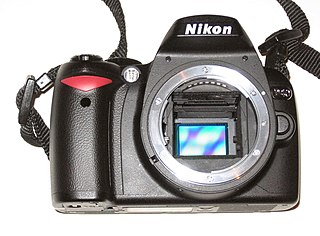
The Nikon DX format is an alternative name used by Nikon corporation for APS-C image sensor format being approximately 24x16 mm. Its dimensions are about 2⁄3 those of the 35mm format. The format was created by Nikon for its digital SLR cameras, many of which are equipped with DX-sized sensors. DX format is very similar in size to sensors from Pentax, Sony and other camera manufacturers. All are referred to as APS-C, including the Canon cameras with a slightly smaller sensor.
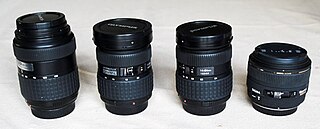
This article is about photographic lenses for single-lens reflex film cameras (SLRs) and digital single-lens reflex cameras (DSLRs). Emphasis is on modern lenses for 35 mm film SLRs and for DSLRs with sensor sizes less than or equal to 35 mm ("full-frame").

The Nikon D90 is a 12.3 megapixel digital single-lens reflex camera (DSLR) model announced by Nikon on August 27, 2008. It is a prosumer model that replaces the Nikon D80, fitting between the company's entry-level and professional DSLR models. It has a Nikon DX format crop sensor.
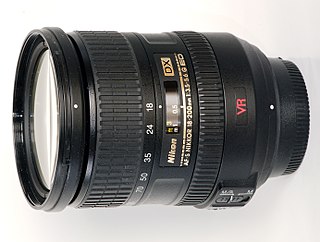
The Nikon AF-S DX VR Zoom-Nikkor 18-200mm f/3.5-5.6G IF-ED is an image stabilised superzoom lens manufactured by Nikon for use on Nikon DX format digital SLR cameras. It provides a single-lens "walk-around" solution for wide-angle through to telephoto shots, as well as close-up photography.

The Nikon AF-S DX Nikkor 35mm f/1.8G is a lens manufactured by Nikon for use on Nikon DX format digital SLR cameras. It provides a field of view on a DX format camera similar to that of a normal lens on a 35mm film format camera.
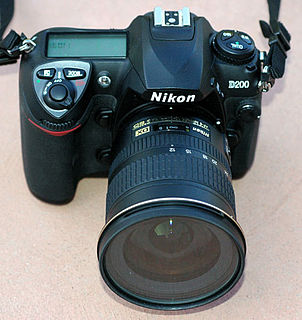
The AF-S DX Zoom-Nikkor 12-24mm f/4G is a lens manufactured by Nikon for use on Nikon DX format digital SLR cameras. It provides an angle of view on a DX format camera similar to that of an 18-35mm lens on a 135 film format camera.

The 18-55mm f/3.5-5.6G AF-S Zoom-Nikkor lens is a midrange zoom lens manufactured by Nikon for use on Nikon DX format digital SLR cameras. Often included as a kit lens on entry-level DSLRs, it also can be purchased separately from the camera body. Nikon first introduced the lens in 2005 and has provided three subsequent updates. Following are the four variants as of 2014:

The Nikon D3100 is a 14.2-megapixel DX format DSLR Nikon F-mount camera announced by Nikon on August 19, 2010. It replaced the D3000 as Nikon's entry level DSLR. It introduced Nikon's new EXPEED 2 image processor and was the first Nikon DSLR featuring full high-definition video recording with full-time autofocus and H.264 compression, instead of Motion JPEG compression. It was also the first Nikon DSLR to provide high-definition video recording at more than one frame rate.

The Canon EF 8–15mm f/4L Fisheye USM is a fisheye zoom lens for Canon digital single-lens reflex cameras (DSLRs) with an EF lens mount. It delivers 180° diagonal angle of view images for all EOS SLR cameras with imaging formats ranging from full-frame to APS-C, and provides 180° circular fisheye images for full-frame EOS models. It features UD glass for suppression of chromatic aberration and a subwavelength coating for reduced ghosting. It has full-time manual focus for instant switching from AF to Manual operation.

The Nikon 1 series is a discontinued camera line from Nikon, originally announced on 21 September 2011. The cameras utilized Nikon 1-mount lenses, and featured 1" CX format sensors.

The Nikon AF-S Zoom-Nikkor 24-120mm f/4G IF-ED VR is a 5x Standard zoom lens with a fixed maximum aperture of f/4 throughout its entire zoom range.
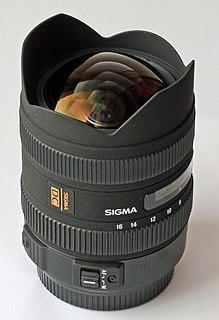
The Sigma 8–16mm lens is an enthusiast-level, ultra wide-angle rectilinear zoom lens made by Sigma Corporation specifically for use with APS-C small format digital SLRs. It is the first ultrawide rectilinear zoom lens with a minimum focal length of 8 mm, designed specifically for APS-C size image sensors. The lens was introduced at the February 2010 Photo Marketing Association International Convention and Trade Show. At its release it was the widest viewing angle focal length available commercially for APS-C cameras. It is part of Sigma's DC line of lenses, meaning it was designed to have an image circle tailored to work with APS-C format cameras. The lens has a constant length regardless of optical zoom and focus with inner lens tube elements responding to these parameters. The lens has hypersonic zoom autofocus.
The 18-300mm f/3.5-6.3G lens is a telephoto superzoom lens manufactured by Nikon for its line of DX DSLR cameras.
The 18-300mm f/3.5-5.6G ED VR is a telephoto superzoom lens manufactured by Nikon for its line of DX DSLR cameras.

The AF-S DX Zoom-Nikkor 10-24mm f/3.5-4.5G ED is a lens manufactured by Nikon for use on Nikon DX format digital SLR cameras. It provides an angle of view on a DX format camera similar to that of a 15-35mm lens on a 135 film format camera.
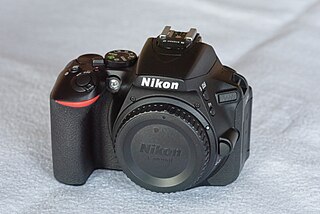
The Nikon D5600 is a 24.2 megapixel upper-entry level, APS-C sensor DSLR announced by Nikon on November 10, 2016 The successor of the D5500. The camera has an F-mount.

















